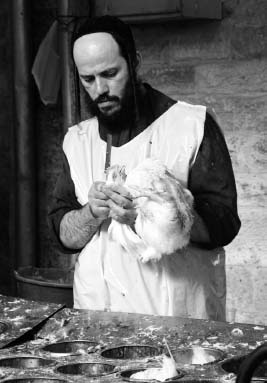JudaismCustoms and Rituals |
What is the significance of keeping kosher? |
Kashrut is the Hebrew term for the use of “ritually pure” (kasher) food. It refers to the way food is prepared as well as to certain types of food. With respect to manner of preparation, the opposite of kasher is terefah, “torn” by a predator, rather than properly butchered. The basic principle here is that an animal’s death by predator constitutes a defect in the animal product. Proper butchering (called shehitah) involves using only perfectly smooth blades to slit the animal’s throat and windpipe, draining the blood, and inspecting for blemishes. With respect to types of food, Jews make a number of major distinctions between what is clean and what is unclean. Clean animals include cattle, sheep, and other ruminants with fully cloven hooves (but not nonruminant mammals like pigs, or those with solid or only partly cloven hooves, such as dogs or horses). Clean birds include pigeons, doves, chickens, pheasant, and domestically raised geese and ducks (but not birds of prey, wild water fowl, or most other common wild birds). All reptiles and amphibians are unclean, but fish with scales and internal bones (as opposed to cartilage, as with shark) are acceptable.
In addition, expanding on the biblical prohibition of “cooking a kid in its mother’s milk” (Exodus 34:26), dairy and meat products may not be combined in any way. Strict observers of kashrut keep separate sets of kitchen tools—some even totally separate kitchens—for meats and dairy products. Kosher practice is an excellent example of the distinction between custom and ritual. Observance of dietary laws often involves, or presupposes, precise ritual action, such as in the kosher method of slaughtering an animal or the care taken not to contaminate utensils. But in general it means simply a customary way of handling food that has religious implications.

In the ceremony of Kapporot, performed during Yom Kippur, sins are transferred to a chicken (or sometimes a bag of coins) and the chicken is ritually slaughtered. The meat is then given to the poor. (Dubova / Shutterstock.com.)
